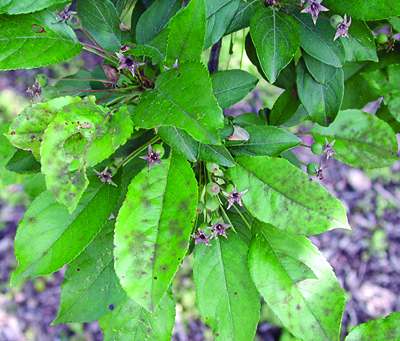Apple scab
July 30, 2015
Cause
Venturia inequalis (fungus)
Hosts
Crabapples and apple vary widely in their resistance to scab. Related (but different) species of the fungus that cause apple scab produce scab on hawthorn, mountain ash and pyracantha.
Symptoms
 Symptoms (below) appear as velvety, olive green spots on leaves varying in size from a pinhead to 1/2 inch. As lesions enlarge, they run together and form larger areas. Leaves turn yellow and drop off in mid-summer. Severely affected trees can be nearly defoliated by September. Fruits may also develop rough, corky, brown spots.
Symptoms (below) appear as velvety, olive green spots on leaves varying in size from a pinhead to 1/2 inch. As lesions enlarge, they run together and form larger areas. Leaves turn yellow and drop off in mid-summer. Severely affected trees can be nearly defoliated by September. Fruits may also develop rough, corky, brown spots.
How it’s spread
The fungus produces two types of spores. Sexual spores are produced on fallen leaves infected the previous year, to infect new leaves by wind and splashing rain. Subsequent infections spread on the tree through asexual spores (called conidia) via wind and rainsplash. The disease is more severe in years with wet spring weather.
Management
Rake up and remove infected leaves from underneath trees. Avoid overhead watering. Apple scab is never fatal but disfigures the tree and reduces vigor. Plant resistant cultivars where possible; see listing below. Registered fungicides can be applied preventatively at 2-week intervals beginning at budbreak until after petal fall.

Resistant crabapples may develop spots on their leaves, but retain their leaves, so the scab is less noticeable.
A partial listing of crabapples evaluated by Michigan State University reported as having no scab to slight scab ( with no defoliation) include the following (listed alphabetically): Malus baccata “Jackii”, “Beverly”, “Bob White”, “David”, M. floribunda, “Harvest Gold”, “Liset”, “Mary Potter”, “Ormiston Roy”, “Prairifire”, “Professor Sprenger”, “Red Jewel”, “Red Splendor”, M. sargentii, “Sentinel”, “Silver Moon”, “Sugar Tyme”, “White Angel”, and “Winter Gold”.
Consult MSU Extension Bulletin E-2177, “Crabapples- A Selection Guide”, for more information.
Print a PDF of this page: Apple scab



 Print
Print Email
Email



